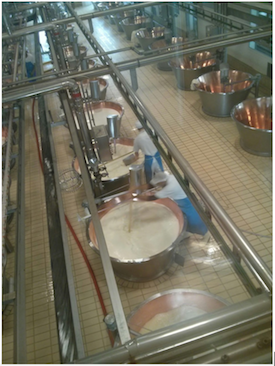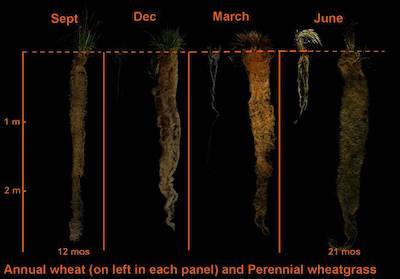Future Now
The IFTF Blog
Food Innovation Recipes: SCALABLE BIODIVERSITY
Some recipes are passed down from generation to generation, becoming long-standing traditions. Others invite us to explore new regions or inspire us to reinvent our bodies. They even encourage us to reimagine the food spaces in our lives, from our kitchens to our marketplaces. The power of recipes is the power to combine ingredients in novel ways.
 As we look at the complex global threats we face over the coming decade, from environmental disasters to income inequality to political conflict, we must consider what Institute for the Future calls ingredients for change—capacities, tools, and platforms to reinvent food experiences with the greatest potential for transformation.
As we look at the complex global threats we face over the coming decade, from environmental disasters to income inequality to political conflict, we must consider what Institute for the Future calls ingredients for change—capacities, tools, and platforms to reinvent food experiences with the greatest potential for transformation.
This post gives an overview of one of these ingredients: scalable biodiversity. Read more about all five in our forecast report, Food Innovation: Recipes for the Next Decade.
Scalable Biodiversity:
Toward robust ecosystems in the gut, factory, and field
Anxiety over the shrinking diversity of plant and animal crops is being tempered by the realization of stunning diversity many orders of magnitude smaller, at the microbial level. Microbes have been our allies in food innovation for hundreds of thousands of years, but our understanding and command of these living ingredients is getting more granular every day. Research in this realm is giving us a new metric in our innovation strategies, while the ability to tap millions of species across scales from microbes to watersheds is opening up new possibilities for the future of food.
High-throughput DNA scanning is rendering entire communities of microbes visible, and the cost of this has been plummeting while research and patents in this area have been growing exponentially over the last several years. An intriguing area of innovation is emerging where this new scientific clarity is intersecting with ancient methods of preserving foods and enhancing flavor. This “microbial terroir” brings rigor to elusive definitions of quality, such as fermentation performance and wine properties across regions. Microbes are now recognized as part of the terroir that each place on earth can potentially bring to the future of food.
Understanding biodiversity at this micro scale not only casts new light on traditional processes but also reframes innovation across the food system in terms of engaging and supporting ecosystems—the ecosystems of bacteria in, on, and around human bodies, soil, processing equipment, and kitchens. As hospitals reconsider their use of antibiotics and closed-system air conditioning, food processors and retailers will also be challenged to find safe and healthy alternatives to commercial sterilization.
Emerging understanding of what keeps the human gut microbiome healthy also links back to biodiversity at the macro scale: a greater variety, especially of plants, is great for the gut. As the evidence around what supports human health on the microbial level evolves, people’s desire for natural diversity in their diets may well accelerate beyond what the current agricultural system supports at scale. Overlap between “what’s good for me” and “what’s good for the planet” will only boost this trend, as awareness of crop blights and other vulnerabilities of industrial monoculture increases.
We’ve developed three forecasts for how scalable biodiversity will unfold as an ingredient for innovation in the next decade, with signals of change from today.
FORECAST: microbes for safety and flavor
From minimizing microbes to cultivating healthy ecosystems
Scaling safe and consistent food production in the 20th century was all about minimizing variables: a few carefully chosen, homogenized ingredients brought into environments as sterile as possible to create a world of flavor. Scalable food innovations in the 21st century will emerge from embracing local microbes, their migration, and their role in achieving food safety outcomes and depth of flavor. We’ll be able to track microbes and use new metrics to make decisions for food safety with unprecedented speed and precision. Collaborations like the ones emerging between bioinformatics powerhouses and the agriculture and food sector will power this new pathway for innovation, while traditional processes for making foods such as cheese that hinge on microbial diversity will find new grounding.
Signal: The Consortium for Sequencing the Food Supply Chain (SFSC) is sequencing the baseline metagenome of all the microbes found naturally across the food supply chain. While most food safety sequencing efforts focus only on known pathogens, a more biodiversity-embracing portrait of entire microbial communities in fields, factories, and warehouses will enable rapid detection of deviations—and allow for preventing food contamination outbreaks at the source.
Signal: The Alfred P. Sloan Foundation’s Microbiology of the Built Environment program is a collaborative effort involving scientists, engineers, and architects in studying the microbial ecology of indoor environments. The knowledge that will emerge from this program—from understanding biomes inside buildings to the impact of different ventilation systems on microbes—will shape the design of supermarkets, kitchens, and transport systems to support food safety.

Signal: Nuova Castelli, the largest producer of certified D.O.P. Parmigiano- Reggiano cheese in Italy, is scaling and automating within the limits of traditional production requirements to respect the natural variation of milk and microbes. Every stage of production, such as washing the kettles for warming milk with whey instead of disinfectant cleanser, manages the microbial ecosystem of the factory to optimize flavor, and in so doing, safety (see photo to the right).
FORECAST: dynamic personalization
From fad diets to microbial nudging
The premise underlying the heated battles of the last decade over what constitutes a healthy diet—namely, that there is one healthy diet that will work for everyone—is becoming increasingly suspect. A decade of research from Stanford to London is finding variations in how even genetically identical twins respond to the same foods and is discerning the active role played by the gut microbiome in these variations. With the proliferation of devices and services that will give people the ability to track their own microbiomes over time or at any given moment, such as uBiome’s at-home sampling kit or emerging ingestible sensors, the next decade will see a vast expansion of support for making food choices based on personalized, dynamic information.
Signal: The Personalized Nutrition Project of the Weizmann Institute of Science, focused on studying the microbiomes of prediabetic individuals and their reactions to “bespoke” diets, has been coalescing over the past several years from Israel’s biotech cluster. Early results from the study are promising that gut microbiome data and algorithmic modeling will yield personalized and effective dietary recommendations. The team’s video explains their research:
Signal: The Unified Microbiome Initiative launched by a group of leading scientists, and the United States’ National Microbiome Initiative, aim to span epicenters of innovative research on the microbiome and connect researchers across disciplines. Within a decade, researchers like Rob Knight at the University of California, San Diego, anticipate bridging the divide between correlative and causative insights, between description and predictive nudging.
Signal: The American Gut Project and the Human Food Project combine a vast collection of citizen-donated microbial samples and compare these DNA-sequenced populations with samples taken from people living traditional farming or hunting- and-gathering lifestyles from Peru to Namibia. While the researchers are duly skeptical of their early findings, the results seem to point toward the healthfulness of a more diversified diet than Westerners typically consume.
FORECAST: food diversification
From diverse guts to diverse crops
The early findings of research projects based on citizen-donated microbial samples suggest that the common denominator of healthy diets for humans is high fiber from naturally diverse, plant-based sources. The relatively low diversity of the modern Western diet, which commonly includes low fiber intake and an unprecedented proportion of animal products, seems to be highly correlated with many of the lifestyle diseases of Western populations. As the evidence evolves, people may demand more natural diversity in their diets than what the current agricultural system can provide at scale. Initiatives to diversify the areas of the world that gave us corn and soy monocrops, including the American plains, could help meet this potential demand, while efforts to realign supply chains toward regenerative supply webs would have global ecological and human health impacts.
Signal: Celebrity chef Gasto?n Acurio is an ambassador of contemporary culinary innovation in Peru, which has grown directly out of the biodiversity of the Andes—including over 2,000 varieties of potatoes—and the micro-entrepreneurial ventures that have thrived on it for millennia. Acurio has used his clout to support both the science and the business of diverse foods and their purveyors.
 Signal: The Land Institute in Salina, Kansas, is breeding perennial grains and researching how to grow them in polycultures—mixtures that enjoy the benefits of the complex ecosystems found in the prairie—with the hope that the first such crops will be field-ready in the next decade or so. Plant breeding efforts like this lead the way in developing alternatives to the world’s current grain supply, obtained from annual plants grown in monocultures (see photo to the right).
Signal: The Land Institute in Salina, Kansas, is breeding perennial grains and researching how to grow them in polycultures—mixtures that enjoy the benefits of the complex ecosystems found in the prairie—with the hope that the first such crops will be field-ready in the next decade or so. Plant breeding efforts like this lead the way in developing alternatives to the world’s current grain supply, obtained from annual plants grown in monocultures (see photo to the right).
- Signal: Terra Genesis, a permaculture consulting group focused on regenerative supply chains, worked with a cosmetics company to reorganize its supply list by climate zone. For instance, almonds are categorized by a Mediterranean climate, though most of the company’s are grown in California. Terra then sought genetic variations from the heirloom orchards in other Mediterranean climates like in Spain and Morocco to design a new kind of Californian almond orchard that, if it works, would actually return water to aquifers. This points to a future in which we transform extractive supply chains into regenerative supply webs.
 ARTIFACT FROM THE FUTURE: Gotta Eat 'Em All
ARTIFACT FROM THE FUTURE: Gotta Eat 'Em All
This particular Artifact from the Future might be something you would see over the coming decade as Scalable Biodiversity revolutionizes the food system. Read about what this image to the right is, and what it means for the future.
HOW WILL YOU CATALYZE FOOD INNOVATION?
Read all of the forecasts and foresight tools in our report, Food Innovation: Recipes for the Next Decade. It explores scalable biodiversity and four other ingredients for change—capacities, tools, and platforms to reinvent food experiences with the greatest potential for transformation.

For More Information
For more information on the Food Futures Lab and its research, contact:
Rebecca Chesney | rchesney@iftf.org



